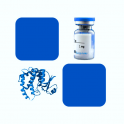
- Remove this product from my favorite's list.
- Add this product to my list of favorites.
Products
Newsletter
 |  |  |  |  |  |

Background
B-lymphocyte antigen CD19 is also known as CD19 (Cluster of Differentiation 19), is a single-pass type I membrane protein which contains two Ig-like C2-type (immunoglobulin-like) domains. CD19 is expressed on follicular dendritic cells and B cells. In fact, it is present on B cells from earliest recognizable B-lineage cells during development to B-cell blasts but is lost on maturation to plasma cells. It primarily acts as a B cell co-receptor in conjunction with CD21 and CD81. Upon activation, the cytoplasmic tail of CD19 becomes phosphorylated, which leads to binding by Src-family kinases and recruitment of PI-3 kinase. As on T cells, several surface molecules form the antigen receptor and form a complex on B lymphocytes. The (almost) B cell-specific CD19 phosphoglycoprotein is one of these molecules. The others are CD21 and CD81. These surface immunoglobulin (sIg)-associated molecules facilitate signal transduction. On living B cells, anti-immunoglobulin antibody mimicking exogenous antigen causes CD19 to bind to sIg and internalize with it. The reverse process has not been demonstrated, suggesting that formation of this receptor complex is antigen-induced. This molecular association has been confirmed by chemical studies. Mutations in CD19 are associated with severe immunodeficiency syndromes characterized by diminished antibody production. CD19 has been shown to interact with: CD81, CD82, Complement receptor 2, and VAV2.
Source
Recombinant Cynomolgus / Rhesus Macaque CD19 (20-292) Protein, Fc Tag (CD9-C5251) is expressed from human 293 cells (HEK293). It contains AA Pro 20 - Lys 292 (Accession # F7F486). In the region Pro 20 - Lys 292, the AA sequence of Cynomolgus and Rhesus macaque CD19 are homologus.
Predicted N-terminus: Pro 20
Molecular Characterization
This protein carries a human IgG1 Fc tag at the C-terminus.
The protein has a calculated MW of 56.7kDa. The protein migrates as 62-95 kDa under reducing (R) condition (SDS-PAGE) due to glycosylation.
Endotoxin
Less than 1.0 EU per μg by the LAL method.
Purity
>95% as determined by SDS-PAGE.
Formulation
Lyophilized from 0.22 μm filtered solution in Tris with Glycine, Arginine and NaCl, pH7.5. Normally trehalose is added as protectant before lyophilization.
Reconstitution
See Certificate of Analysis for reconstitution instructions and specific concentrations.
Storage
For long term storage, the product should be stored at lyophilized state at -20°C or lower.
Please avoid repeated freeze-thaw cycles.
This product is stable after storage at:
-20°C to -70°C for 12 months in lyophilized state;
-70°C for 3 months under sterile conditions after reconstitution.
(1) "Atypical memory B cells increase in the peripheral blood of patients with breast cancer regardless of lymph node involvement"
Azizi, Mehdipour, Samadi et al
BMC Immunol (2024) 25 (1), 25
(2) "ABBV-319: A CD19-targeting glucocorticoid receptor modulator antibody-drug conjugate therapy for B-cell malignancies"
Chang, Emberley, D'Souza et al
Blood (2024)
(3) "Association of immune cells and the risk of esophageal cancer: A Mendelian randomization study in a East Asian population"
Guo, Si, Si
Medicine (Baltimore) (2024) 103 (18), e38064
Showing 1-3 of 16395 papers.
Follow us